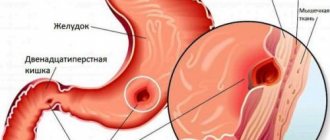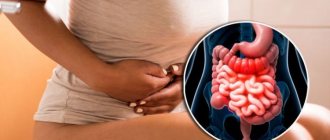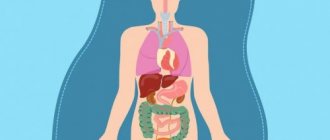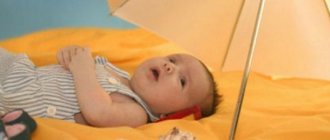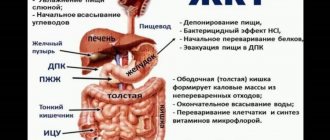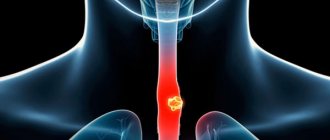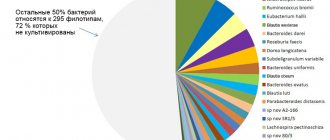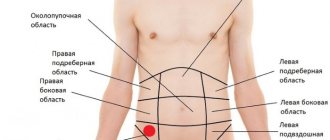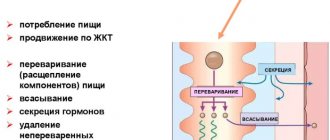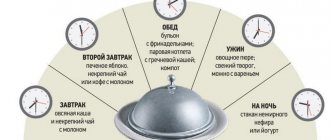Pain in the left side can be caused by a variety of reasons. In the simplest case, this is associated with gas formation or intense training, intense walking, running. In this case, the pain stops quite quickly. But if they recur or are severe, you should immediately consult a therapist or call emergency help.
Anatomy of the left side of the human abdomen
To successfully diagnose the underlying disease and understand the causes of pain, you need to know what is on the left side of a person’s lower abdomen. Any organ can cause pain. Thanks to the work of the nervous system, pain is often reflected onto a neighboring organ (this often happens with the kidneys). Such pain in medicine is called “referred”.
Medicine identifies the following bone formations and organs in the left abdominal cavity:
- abdominal wall and lower ribs;
- spleen;
- pancreas;
- duodenum, small and large intestines;
- left kidney and ureter;
- vessels and nerves of the abdominal cavity.
Each of these areas of the human body can cause discomfort and pain. An accurate diagnosis can only be made by the attending physician based on the results of tests and studies.
Let's sum it up
As you can see, initially, based on the location of the disease, it is impossible to say which organ is affected, because the mechanisms of pain within our body vary. It is not at all necessary that the organ located directly under the ribs on the left is sick; it is quite possible that the pain sensations are simply reflected.
A symptom such as abdominal pain can be a sign of a large number of different diseases. It is necessary to take into account that the stomach is not a separate organ - it is just the name of an anatomical region of the human body. The abdomen contains many internal organs, consisting of a variety of tissues and structures, so the cause of pain can vary significantly. To correctly diagnose abdominal pain, first of all, it is necessary to clarify such an important sign as its localization. In turn, it is possible to correctly localize pain only if you have a good understanding of the abdominal area.
Causes of pain in the left side of the abdomen
Now you know what is on the left side of the stomach. Painful sensations in this area can be caused by many diseases, both chronic and acute. Most of the symptoms of pain are associated with damage to the pancreas and gastrointestinal tract.
There are the following types of pain:
- Organ pain, which is characterized by the presence of pathology of one or more organs. This can be an inflammatory, infectious, ischemic process. At the same time, the sensations change: they fade away, then return with renewed vigor. The pain can be either acute or aching in nature.
- Parietal pain is characteristic of the abdominal wall and is most often associated with inflammatory processes or internal furunculosis.
- Neurogenic pain occurs when there are problems with nerve fibers, which transmit impulses between organs and the central nervous system.
- Referred or mirrored pain occurs quite often in patients and is characterized by localization in a completely different place from the location of the affected organ. For example, due to cysts on the left ureter, the patient may feel pain in the right side of the lower back.
What can cause pain under the ribs on the left: causes
Pain under the ribs on the left front and back can be caused by various diseases.
It is impossible not to notice if the painful sensations have passed and are not bothering you at the moment. Especially if, along with the pain under the ribs on the left, there was also a burning sensation. This is a very important signal about an illness that needs to be treated without delay. Localization of pain in the hypochondrium is possible when there are malfunctions in the functioning of specific body systems. What could cause discomfort in the front and back in this area? Here are the reasons:
- Heart disease
- Inflammation in the pulmonary system
- Tumors or inflammatory processes in the diaphragm area
- Ailments related to women
- Ulcerative conditions, gastritis in the gastrointestinal tract
- Pathologies of the small or large intestine
- Improper kidney function
- Pathological processes in the spleen
- Pancreatitis
- Osteocondritis of the spine
- Postoperative complications
- Consequences of increased physical activity
- Injuries
Such inflammatory processes, pathologies and abnormalities in the functioning of organs inevitably become the cause of pain. Health, possibly even life, may be in danger.
Important: Do not self-medicate. The first step is to see a specialist as soon as possible.
Abdominal wall
These are soft tissues that prevent damage to the internal organs that are located on the left side of a person’s lower abdomen. When complaining of acute or nagging pain, patients most often point to the anterior left part of the abdominal wall. It consists of several layers:
- skin and subcutaneous fat - this layer is characterized by inflammation of the hair follicles, which in some cases can cause painful rashes;
- the internal organs that are located on the left side of the abdomen are protected from damage by a layer of muscles attached to the inner wall of the abdominal cavity (these are the rectus abdominis and oblique abdominal muscles);
- fascia - dense sheets of connective tissue that separate muscles.
The back and side walls of the abdominal cavity are much thicker, since powerful back muscles are located there.
Pain in the peritoneum can occur due to peritonitis, pelvioperitonitis, acute or chronic mesadenitis.
Pyelonephritis
Pain in the left side of the abdomen
The chronic form of any disease makes life very difficult. So in the case of a chronic form of kidney inflammation, also known as pyelonephritis, patients are bothered by a nagging pain in the lower abdomen. The pain can spread to the left or right side, or maybe to both sides of the abdomen, in most cases it will appear in the back of it. In this case, the patient suffers from pain when urinating, fever, and also experiences fatigue or weakness.
Lower left ribs
On the front left side, the ribs completely cover the area of the spleen and partially cover the left side of the stomach. In the case of splenomegaly, the spleen protrudes from under the lower rib and is easily palpable.
There are twelve pairs of ribs in total. The upper seven pairs (the so-called true ribs) are attached to the sternum in front and to the spinal column at the back. The three lower pairs of ribs (called “false ribs”) are fused, thereby forming the costal arch. Even lower are two pairs of ribs (“floating”) - they are not attached to either the sternum or the spinal column. They end in the muscle layer on the side. Some people may occasionally have a thirteenth pair of ribs - this is a physiological feature.
The spleen and its role in the body
The spleen is an unpaired organ located above and to the left in the abdominal cavity. With normal physiology, the ribs completely cover it, protecting it from injury and impact.
It is in the spleen that a number of blood cells are formed, filtration and accumulation of blood occurs, and red blood cells cease their action. The organ tissue consists of red and white pulp. The spleen is adjacent to the stomach, diaphragm, part of the large intestine, and pancreas.
Aching or acute pain occurs in the spleen with the following diseases:
- splenomegaly;
- perisplenitis;
- rupture or infarction of the spleen;
- vascular thrombosis.
With diseases of the spleen, the patient is characterized by weakness, asthenia, bad mood, and low performance. What is located on the left side of the abdomen, besides the spleen, and causes discomfort to the patient, you will find out below.
Stomach as a source of pain on the left side of the body
This organ is located in the center of the abdominal cavity, but most of it is located on the left. It is the second organ of the gastrointestinal tract after the esophagus. At the entrance to the stomach there is a ring-shaped muscular sphincter. A similar, but smaller size is also available at the outlet. The stomach is necessary for the normal functioning of the gastrointestinal tract; it is the “battlefield” of enzymes and acids produced by the pancreas, gall bladder and liver. With stomach diseases, as if by a “domino effect,” all human life and health collapses.
Patients often wonder what organ is located in the left lower abdomen, while the stomach is the source of discomfort. Pain from an ulcer can radiate through nerve fibers to the upper and lower parts of the abdominal cavity. Gastritis pain is easy to distinguish, since it is most often associated with food intake - it is aggravated by hunger and overeating. Erosion of the lower part of the esophagus and the mucous membrane of the stomach walls can also cause serious discomfort for the patient.
Stomach polyps are also a common reason for patient questions about what is on the left side of the abdomen and hurts. Gastric polyps are benign tumor formations. Most often, they develop gradually, over many years, due to the growth of the mucous membrane, which is characterized by an inflammatory process. If the polyps are small, they do not manifest themselves for many years. When it grows, it causes nagging pain in both the left and right sides of the abdomen.
Reasons why the left side of the head hurts
Headache on the left side can be caused by various reasons. It does not necessarily occur in diseases - painful sensations can also appear in healthy people due to stress or fatigue. Doctors at the Clinical Institute of the Brain advise you to go for an examination if the pain continues for more than 2-3 days in a row or bothers you too often. It is impossible to determine the exact cause at home or during a simple examination, but the doctor will need information about how the pain began, how long it lasts, in what area it occurs and with what intensity.
Physiological reasons
Even a healthy person, without any disorders or chronic diseases, can have a headache in the left area. If this symptom occurs once, is not very intense and goes away quickly, including after taking painkillers, there is no reason for concern. However, it is important to understand what can trigger a headache attack on the left side of the head in order to avoid such manifestations.
- Intense physical activity is the reason for accelerating blood circulation and activating the central nervous system. As a result, symptoms such as headache, dizziness and dark circles before the eyes, shortness of breath and tingling in the heart area may appear. To relieve them, a good rest is often enough; if the left side of your head hurts badly, you should take a painkiller tablet.
- Stress is one of the most common headaches. They arise as a result of increased concentrations of the hormones adrenaline, cortisol, angiotensin and others. They provoke vasoconstriction and increased blood pressure. To relieve pain, it is recommended to rest and resolve stressful situations, otherwise dangerous consequences are possible: chronic headaches, increased risks of stroke.
- Prolonged mental stress, including working at a monitor without breaks, can cause severe pain in the left area of the head. Constant concentration and tension, especially in a sitting position, is dangerous to health. Doctors recommend taking breaks of at least 5-10 minutes every hour and doing a light warm-up.
- Abuse of tonic drinks, which include tea and coffee, is one of the reasons why a healthy person may have a headache. They contain substances such as caffeine and tannin. These are plant components that cause a constriction of the blood vessels that supply the brain. This effect is often accompanied by an increase in blood pressure.
- Alcoholic drinks in large quantities are not a cure for headaches, but the cause that causes them. Ethyl alcohol first dilates blood vessels, and then provokes their sharp narrowing. Jumps in blood pressure are accompanied by pain, weakness and impaired heart function.
- Smoking is a source of nicotine, as well as hot vapors of other harmful compounds. This habit provokes the development of atherosclerosis, in which the lumen of the arteries narrows and they cannot supply enough oxygen to the brain. In addition, smokers often suffer from high blood pressure.
Most of the factors that cause pain in the left hemisphere of the head in a healthy person are related to habits and lifestyle. Doctors recommend completely giving up bad habits and spending time relaxing and walking in the fresh air. As a result, you can notice a significant improvement in your well-being and get rid of headaches.
Pathological conditions in which the left side of the head hurts
Pain on the left side of the head requires examination if it occurs frequently and is of high intensity. There are a number of reasons that can cause this symptom. These diseases can progress, so at the initial stage it is important to determine their cause and select an effective treatment regimen.
Migraine
An acute headache that occurs for no apparent reason and is highly intense is a migraine. During the examination, no functional impairment is observed, but it is known that this type of pain on the left side of the head is vascular in nature. Symptoms last from 4 hours to 3 days, and a migraine aura appears before the attack begins. It includes typical symptoms:
- nausea and vomiting;
- increased sensitivity to light, smells, auditory and tactile stimuli;
- numbness or tingling sensation on the skin of the face and hands;
- decreased visual acuity.
Statistically, women are more likely to suffer from migraines. Despite the fact that its primary cause has not been discovered, each patient has his own factors that can trigger another attack. This could be certain smells, foods, alcoholic drinks, extreme fatigue or stressful situations. You can relieve symptoms with painkillers, but they are not effective enough for migraines.
Tension headaches
Tension headaches are often symmetrical, but can also occur only on the left side. This is a complex of symptoms that develops due to stress, chronic fatigue, and muscle tension in the neck. One of the reasons why pain in the left head can occur on an ongoing basis is injuries in the cervical spine. The patient is concerned about characteristic manifestations:
- compressive pain that covers the temple and back of the head, spreading to the area behind the eyes;
- muscle tension in the neck and shoulder girdle;
- Symptoms increase towards the end of the day.
To get rid of pain in the head on the left, it is recommended to monitor your posture. Massage therapy can also help, but should be performed by an experienced professional, especially if there has been previous injury in the area.
Cluster headaches
Cluster headaches are considered the most intense and can significantly affect the patient's daily life. They arise in one part of the head or spread over its entire surface, often affecting the area behind the eyes, forehead and temple. Additional signs also appear:
- nasal congestion, difficulty breathing;
- ptosis - drooping of the eyelid;
- increased sensitivity to light in one eye, watery eyes;
- redness of the facial skin, increased sweating.
Cluster headaches are one of the rarest types. Their exact cause is unknown, but they often occur at regular intervals, in spring or autumn. The attack lasts for 5-10 minutes, and then the pain becomes less acute and persists for up to 3 hours. A characteristic sign of cluster pain is that it begins every day, at a certain time, for 1–3 months.
Diseases of the cervical spine
Pain in the left hemisphere of the head can be caused by diseases of the cervical spine. Here pass important vessels and nerves that carry blood and impulses to the brain. Their compression or inflammation leads to acute headaches, including unilateral ones.
- Osteochondrosis is a chronic disease in which degenerative changes occur in the cartilage layer between the vertebrae. They become less durable and elastic, and therefore lose their ability to absorb shock during movement. The space between adjacent vertebrae narrows, which leads to compression of blood vessels and nerves. Soreness manifests itself after a long stay in a sitting position or after exercise.
- Displacement of the vertebrae is a dangerous condition that leads to acute pain, inflammation of the nerves and compression of blood vessels. Most often this condition is associated with injuries, falls, or increased stress on the neck area, but in some patients the displacement can also occur in a calm state. In this case, congenital instability of the vertebrae and weakness of the neck muscles are important.
- Protrusion - protrusion of the intervertebral disc, the initial stage of a hernia. The process is accompanied by acute pain in the neck and one part of the head; any movement is difficult. The diagnosis can be made based on analysis of x-rays. The pain in the left hemisphere of the head goes away if the integrity of the spinal column is restored and the compression of blood vessels and nerves is relieved.
Chronic neck diseases require timely treatment as they can progress. The Clinical Institute of the Brain has all the conditions for a full diagnosis, as well as treatment and recovery from injuries, osteochondrosis, vertebral displacement and intervertebral hernias.
Atherosclerosis
Atherosclerosis is a chronic vascular disease that occurs when fat metabolism is impaired. Some products, including cholesterol, are not excreted, but accumulate in the blood and settle on the walls of the arteries. The vessels become fragile, insufficiently elastic, and cannot fully narrow or expand in response to increases and decreases in pressure. There are a large number of factors that can lead to the development of atherosclerosis, including:
- frequent consumption of fatty foods of animal origin (the main source of cholesterol);
- disruption of the secretion of enzymes that are involved in fat metabolism;
- liver diseases;
- overweight and sedentary lifestyle;
- smoking and alcohol abuse.
With atherosclerosis, a headache may occur on the left or right due to impaired blood supply to the brain. Painful sensations are often associated with increased blood pressure. The inability of the blood vessels to dilate and compensate for this condition leads to acute pain, dizziness, nausea and other alarming symptoms.
Traumatic brain injuries
Pain in the left hemisphere of the head can appear even long after injury. Concussions, bruises, open and closed craniocerebral injuries cause disruption of the blood supply to certain areas of the brain. Even in patients whose nervous activity is completely restored, pain may be felt after exercise and due to changes in weather. Injuries often trigger chronic migraines. The pain can be relieved with painkillers, and the doctor will help you choose the most suitable option.
Stroke
An acute headache on the left side of the head is one of the first signs of a stroke. In this condition, a sudden disruption of cerebral circulation occurs, resulting in areas of ischemia. The process can be determined at home, but it is important not to miss its first manifestations:
- acute headache, often one-sided;
- increase or decrease in blood pressure;
- pain in the heart area;
- asymmetry of movements of facial muscles and limbs;
- loss of consciousness.
The most common type is ischemic stroke. It occurs when there is an acute disturbance of cerebral circulation due to vascular disease or blockage. Atherosclerosis, stress and other factors can lead to an attack. Hemorrhagic stroke is less common, but is more life-threatening. It is accompanied by rupture of the vessel and the release of blood into the brain. It can accumulate in the brain ventricles or meninges, thereby provoking the appearance of areas of necrosis. Help for a stroke can only be obtained in a hospital, in an inpatient setting. Doctors at the Clinical Institute of the Brain emphasize that the highest probability of a favorable outcome remains if you seek help in the first 2 hours.
Neoplasms in the brain
Tumors and cysts can cause acute headaches, including unilateral ones. Neoplasms disrupt the processes of cerebral circulation, compress blood vessels and nerve tissue. The pain is chronic and always appears in the same area, but can spread to the entire surface of the head. The diagnosis is made based on CT or MRI data, and treatment tactics are selected individually. Early diagnosis of lumps is important because over time they can grow in size and cause more dangerous symptoms.
Colds
Colds and flu are common infectious diseases that appear more often during the cold season and in the off-season. The virus infects the upper respiratory tract and causes a persistent increase in temperature. Headache is also considered one of the characteristic symptoms. It is associated with pressure changes, high temperature, and also with the accumulation of exudate in the nasal sinuses. It decreases after rest and taking antipyretic drugs.
Arterial hypertension
Increased blood pressure is one of the main causes of headaches in the left area of the head. With hypertension, it is one-sided, pulsating, and can spread to the temple area or the back of the head. At home, you can measure your blood pressure using a tonometer. Normally, the result is about 120/80 mmHg; hypertension can be considered when the result is 140/90 mmHg. and more. An attack of hypertension may also be accompanied by additional symptoms:
- tinnitus, temporary deterioration in hearing and vision;
- rapid heartbeat;
- redness of the facial skin;
- painful sensations and discomfort behind the sternum.
Attacks of hypertension are often triggered by intense physical activity, stress and nervous tension. They appear more often in hot weather and in poorly ventilated areas. The pressure increases due to the need to increase the supply of oxygen to the cells. To normalize blood pressure, it is recommended to ventilate the room and take medicine.
Duodenum and its diseases
The section of the intestine that connects the stomach to the small intestine is called the duodenum. Part of it is located on the left side of the peritoneum. It has many bends, some of which also enter the right territory.
The duodenum performs the following functions:
- partial additional breakdown of food;
- maintaining an alkaline environment;
- promotes the production of pancreatic enzymes;
- It is in this part of the intestine that the main emulsification of fats occurs.
The most common ailment of this organ that provokes pain is a duodenal ulcer. This disease is characterized by aching, excruciating pain. They can appear both during the day and at night, periodically disappearing and appearing again. What is located on the left side of the abdomen and causes discomfort? These are probably manifestations of diseases of the duodenum, pancreas or kidney problems.
Pancreas
Which organ is located on the left side of the abdomen, produces enzymes, insulin and is sensitive to alcohol and poor nutrition? Of course, this is the pancreas. A small organ is of great importance in the overall well-being and functioning of a person. It is divided into left and right sides, between which the “body” of the pancreas is located. It is located retroperitoneally in the body, that is, it does not directly contact the muscular wall of the abdominal cavity. Adjacent to the posterior wall of the stomach, duodenum and spleen.
The functioning of the pancreas is important not only in digestion, but also in the endocrine system. It produces the most important hormone insulin, the lack of which develops diabetes mellitus and other endocrine and hormonal disorders.
Pancreatitis occurs with poor diet and frequent drinking of alcohol. This disease is an inflammation of the pancreas and becomes a source of severe, sharp pain. If this condition is not treated, pancreatic necrosis develops, which is almost always fatal. Pain with pancreatitis is always associated with meals and worsens after fatty foods (kebabs, fast food, pizza, fried potatoes, fatty meat) and alcoholic libations.
If the patient wonders what is on the left side near the abdomen, while experiencing sharp pain in this area, you should urgently consult a doctor. This is probably pancreatitis.
Prevention of diseases that cause pain on the left under the ribs
Prevention of diseases that cause pain on the left side under the ribs.
Disease is easier to prevent than to cure. Therefore, preventative measures are very important. First of all:
- Proper nutrition. Try to eat less spicy and fatty foods. It can be the cause of the development of many gastrointestinal diseases.
- A healthy lifestyle is another measure to prevent pain. Give up bad habits, rest well and get enough sleep.
- Advice for women - wear comfortable underwear made from natural materials, and regularly get examined by a gynecologist.
- For men, a dangerous disease is prostatitis . Take care of yourself, do not overwork, stop smoking and alcohol, and avoid intense physical activity.
If you know exactly what causes the pain, you can use the remedies recommended by traditional medicine:
- Decoctions of herbs, such as rose hips.
- Honey with added cinnamon and other similar natural products.
But even in this case, you need to be very careful about yourself and monitor your body’s reaction. If you want to supplement the main treatment with traditional medicine, first consult a doctor. After all, for example, it is prohibited to consume fresh vegetable juices for all acute and chronic diseases of the gastrointestinal tract and urinary system. This may make the condition worse. To ensure that you always feel good, you should adhere to the following recommendations:
- Get a full medical examination periodically.
- If you have chronic diseases, follow all the doctor’s advice and prescriptions.
- At the first signs of pain, especially acute and sudden pain, consult a doctor immediately.
- Be careful to avoid injury.
You can't ignore pain, but you shouldn't be afraid of it either. Any disturbance in the functioning of the body requires qualified assistance from a specialist. Don't neglect this help and stay healthy!
Small and large intestine
The longest part of the gastrointestinal tract is the small intestine. This is where food is completely broken down. Here, almost all nutrients are absorbed into the blood - amino acids, vitamins, minerals. Remains of food and fiber continue their movement through the intestines. Loops of the small intestine occupy the posterior lower part of the abdominal cavity, predominantly the left side. Part of the small intestine is also located on the right side. In this part of the intestine, smooth muscles are well developed, which contract and push masses forward. This is the process called intestinal peristalsis.
The diameter of the large intestine is much larger than that of the small intestine. The main function of this area is the formation of feces. A lot depends on the microflora of the colon.
The following sections of the large intestine are located on the left side of the peritoneum:
- splenic angle;
- descending colon;
- sigmoid colon;
- transverse colon.
What is located on the left side of the abdomen in men and women and can cause nagging pain and discomfort? Most likely, this is the large intestine making itself known. This may be colitis, proctitis, irritable bowel syndrome, left-sided ulcerative colitis, spastic constipation. For an accurate diagnosis, you need to contact a gastroenterologist.
Causes of pain
In most cases, patients experience intestinal colic, which is what modern doctors pay a huge amount of attention to. Since this clinical sign can often indicate serious pathologies of the intestinal tract and organic deformations. Wherever a painful symptom appears below or on any side, it is important not to relieve its intensity, but to find the cause.
- Including excessively cold food and expired products in the diet. In this case, intestinal irritation occurs, not only colic may occur, but also flatulence, problems with stool, nausea, vomiting, pain in the lower abdomen, and a feeling of heaviness.
- Failure to follow the rules of a healthy diet: abuse of snacks, dry foods, fried, fatty, salty and spicy foods. Preference for fast food.
- Pathological processes of the digestive organs: erosion, ulcers, gastritis. In these situations, incompletely digested food enters the intestines, provoking its spasm. As a rule, pain occurs on the left or lower abdomen.
- Intoxication of the body with contaminated food products.
- Prolonged stay in a depressed or stressed state. Most often, this form develops in women and has become rapidly spreading over the past few years.
- The presence of pathogenic microorganisms in the body, in particular bacteria. Localized in the intestine, such pathological agents almost continuously affect its walls, causing irritation of nerve tissue. Associated symptoms are vomiting, nausea, sudden weight loss, decreased appetite, dull pain in the lower abdomen, flatulence, diarrhea.
- Intoxication with salts of heavy metals. This reason is extremely rare in women, since the risk group is mainly for men working in chemical or heavy production. The most dangerous thing is lead ingestion, accompanied by intense colic and pain.
In addition, colic can occur against the background of decreased immunity and acute respiratory viral infections. The infection affects not only the organs of the respiratory system, but also penetrates the lymph nodes and digestive organs, provoking the development of the inflammatory process.
Left kidney and ureter
These organs are a common cause of pain. The left kidney is located below, just below the level of the lower back on the left side. The left ureter is located next to the anterior abdominal wall. This is a thin tube about twenty centimeters long, which is directed from the hilum of the kidney to the bladder.
What is located in the lower left abdomen in men and is the source of pain? Most likely it's a kidney. Pain can occur with nephroptosis, hydronephrosis, pyelonephritis, glomerulonephritis, and urolithiasis.
Patients often ask the question: “What hurts and what organ is located in the left lower abdomen?” Depending on the nature and severity of pain, we can conclude that the cause is in the organs of the urinary system.
If a stone comes out, the pain will be sharp and unbearable. You need to contact an ambulance. If the patient has a fever, feels feverish and nauseous, and the lower back ache on the left side, most likely he has pyelonephritis or glomerulonephritis. In this case, it is also forbidden to let the disease take its course. Without medical intervention, even death is possible.
What is located in the lower left abdomen that causes throbbing pain that occurs from time to time? This is probably sand passing through the ureter. 65% of men and women have a tendency to form kidney stones (this is also facilitated by the quality of drinking water). But more often than not, the stones never form and come out in the form of tiny sand through the ureter. This process causes a sharp, passing pain on the left side of the lower abdomen. If the sand comes out through the right ureter, the sensations will be concentrated on the right.
Vessels and nerves of the abdominal cavity
The blood supply to the peritoneal organs is a complex topic, which will take a lot of time to delve into. The most important artery of the abdominal cavity is a large vessel called the abdominal aorta. It is a continuation of the thoracic aorta. The abdominal aorta branches to every organ, to every tissue.
The main branches of the abdominal aorta:
- superior mesenteric artery;
- inferior mesenteric artery;
- lumbar and inferior phrenic arteries;
- ovarian arteries;
- renal arteries;
- adrenal arteries.
The main nerve plexuses located on the left side of the abdominal cavity are:
- abdominal aortic;
- sunny;
- diaphragmatic;
- hepatic;
- upper and lower gastric;
- adrenal;
- splenic.
What is located on the left side of a person’s abdomen and can cause pain of a sharp, sudden nature? Perhaps these are vascular diseases of the abdominal cavity. The most common of them:
- mesenteric thrombosis;
- abdominal aortic aneurysm;
- atherosclerosis of mesenteric arteries;
- thrombosis of the arteries of the abdominal organs.
These are very complex diseases, and you cannot diagnose them yourself. It is necessary to undergo a comprehensive examination by a phlebologist, angiologist, cardiologist, and neurologist.
What is located on the left side of the abdomen in women and causes pain?
Here is an approximate list of causes of pain in the left half of the peritoneum among the fair sex:
- urological ailments;
- problems with gynecology;
- gastroenterological diseases;
- various injuries (the rarest cause, but you should not forget about it).
What is located in the left lower abdomen in women and causes nagging pain? Discomfort in the left side of the abdomen can be caused by inflammatory, infectious, chronic or acute processes in the internal organs. Often, during the initial visit, pancreatitis, pyelonephritis, ulcers or erosions of the gastric mucosa, passage of a kidney stone, ureteral rupture, and gynecological problems are diagnosed.
Gynecological pain is characteristic only of the lower abdomen, above the pubic bone. Gynecology is often confused with pain in the gastrointestinal tract. It is possible to make an accurate diagnosis only after passing all tests and examinations (ultrasound, MRI, CT, radiography).
The nature of the pain on the left above the ribs, below them, in front and behind: what can be done?
Sharp and acute pain on the left under the ribs
It is important to take into account the nature of the painful discomfort, since each pathology has its own manifestations. But everyone needs to remember that if there is severe pain in any part of the body, you must immediately call an ambulance. During the course of some diseases, especially in old age, minutes count, and delay can cost the loss of health and even life. This is what the nature of the pain can be if unpleasant sensations arise above, below, the ribs, on the left, in front and behind:
SHARP AND ACUTE PAIN:
- In cases where such pain is the cause of concern, this may indicate significant damage to one of the organs. Moreover, if it was preceded by bruises or injuries to the left side of the body.
- Possible damage to the integrity of the ribs, spleen, and kidneys. It is very dangerous.
- In case of sudden severe pain, you should definitely call an ambulance.
What to do:
- Before the team arrives, the patient must lie down. You can only drink warm water.
- You can take an antispasmodic drug, but you should first consult with an emergency medical technician.
- It is good to apply a cool heating pad to your stomach. The cold will ease the pain a little.
- It is forbidden to use hot heating - this must be remembered.
STITCHING PAIN:
- Appears during physical activity.
- Perhaps you didn't warm up enough before your workout.
- The body was not prepared for the additional load. This happens quite often during active training.
What to do:
- You need to stop the lesson, take a break.
- The body will return to normal, the pain will calm down.
Remember: Before training, be sure to do a good warm-up. It is recommended to start playing sports no less than an hour and a half after eating.
- There is also a frequent repetition of painful sensations, which begins for no particular reason and lasts for a long time.
- Often the pain is accompanied by additional symptoms - nausea, vomiting, gastrointestinal upset.
- Listen to yourself. If there are any additional symptoms, a serious illness may be developing: inflammation or other disruption of organ function.
- In this case, you need to immediately contact a specialist. The doctor will definitely prescribe an examination for inflammation and to exclude oncology.
ACHING AND DULL PAIN:
- May occur in chronic diseases.
- Sometimes it is caused by osteochondrosis, ischemic disease, or angina pectoris.
- Aching and dull pain can last for a long time.
- She doesn't seem to cause much concern. You can even get used to the discomfort and not pay attention. But it's not right.
- Chronic diseases also require mandatory treatment and monitoring by a specialist.
- In addition, they often get worse. Then the pain becomes more severe. Often exacerbations occur at night, depriving sleep.
- Such exacerbations can lead to irreparable consequences.
PULSATING:
- This type of pain may be a sign of pancreatitis.
- It is usually accompanied by other symptoms: diarrhea, vomiting containing bile. It will not be possible to do without the help of doctors.
- Pancreatitis is a serious disease that requires long-term treatment and adherence to a strict diet under the supervision of a doctor.
- This symptom may appear after eating, especially after eating fatty and spicy foods.
- You won't be able to cope with this situation on your own.
PERIODIC:
- Such pain is most often associated with specific features in human physiology.
- This pain can be caused by increased physical activity, lifting something too heavy, as well as being in an uncomfortable position for a long time.
- Overeating can also trigger this type of pain.
- The person may not have serious illnesses.
- But, if such pain occurs regularly, then you should not refuse the examination.
WHEN INHALED:
- Discomfort in the hypochondrium when inhaling may appear with a subdiaphragmatic abscess.
- The pain is intense, sharp.
- Decreases when sitting or lying down.
- If you start moving again, the discomfort intensifies.
- Body temperature may rise, chills and weakness may appear.
- Such symptoms are also possible with trauma and peritonitis.
BY PRESS:
- Indicates intestinal obstruction, inflammation in this organ.
- There may also be a putrid odor from the mouth, a coating on the tongue, bloating, and constipation.
- Sharp pain when pressed and not only in this area indicates a splenic rupture.
- The presence of internal bleeding may be indicated by: tachycardia, pale skin, weakness, cold, tense abdominal muscles.
IF PREGNANCY:
- The natural cause of pain and other discomfort in the hypochondrium during pregnancy is the growth of the fetus.
- The child increases in size, puts pressure on the mother’s internal organs and therefore pain appears.
- The discomfort in this case is usually short-lived and may intensify with inhalation and exhalation.
- If the pain is prolonged, this may indicate the development of gastrointestinal pathologies.
- This symptom can be caused by pneumonia, pathologies of the spleen, renal colic, spasm of the abdominal arteries.
GIRdle PAIN IN THE LEFT HYPOQENTUM:
- Sharp or aching pains that run in a “stripe” across the entire abdomen from the left side to the right or vice versa indicate pancreatitis, exacerbation of chronic gastritis or duodenal ulcers.
- Additionally, a burning sensation and pulsation in the epigastrium may appear.
- If the pain does not subside, then peritonitis is suspected.
In any case, in case of any pain, you should consult a doctor for advice. Read more below.
